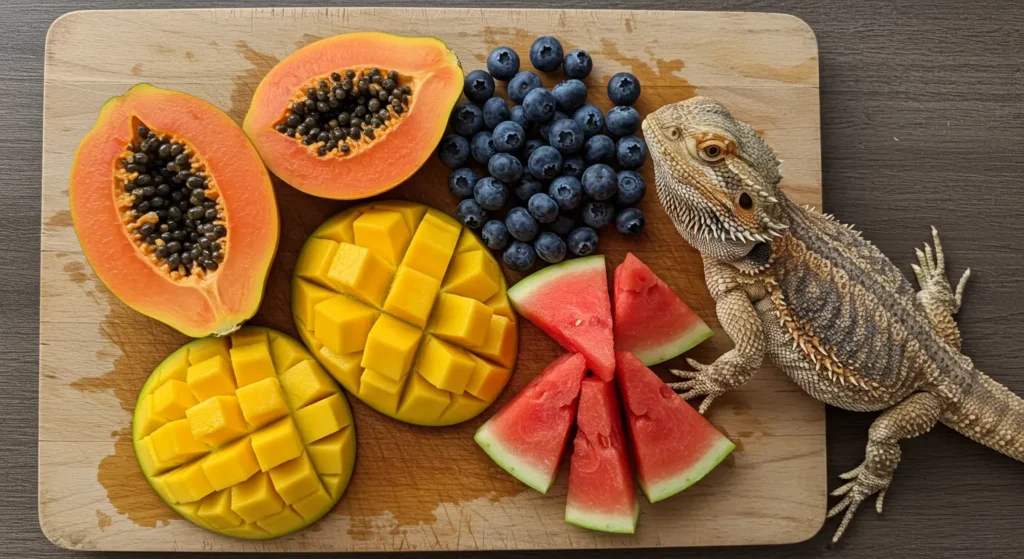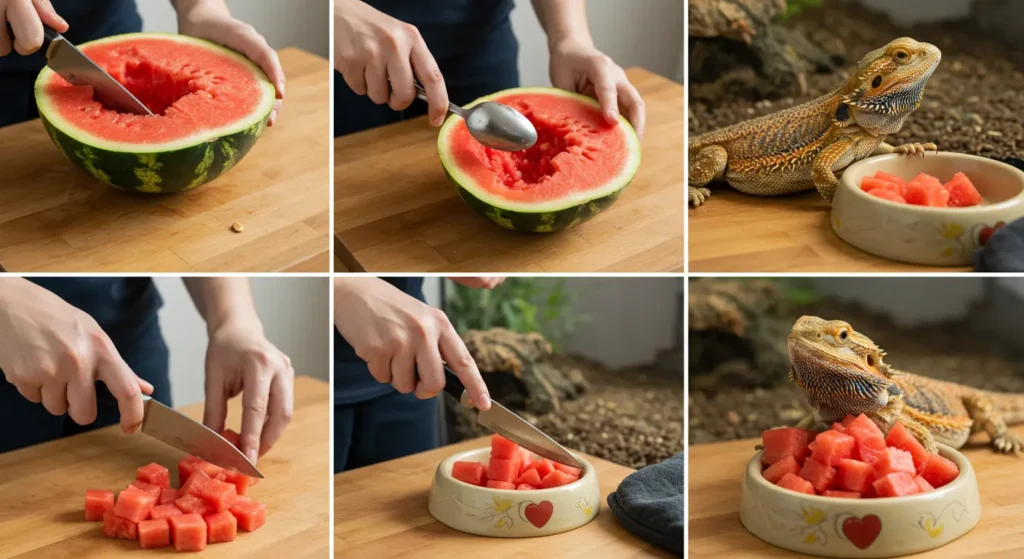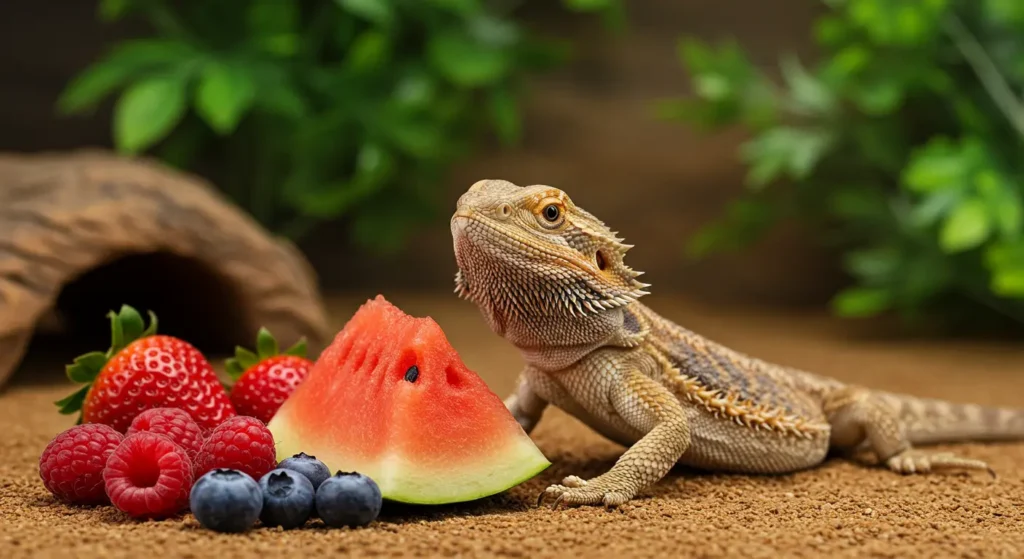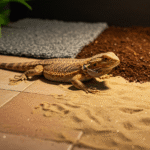Can bearded dragons have watermelon? If you’ve ever enjoyed this juicy summer fruit and wondered whether your scaly companion can join the treat, you’re not alone. Many reptile owners ask the same question: Can bearded dragons have watermelon safely, or should it be avoided? While watermelon is hydrating and sweet, it’s not always the best fit for a bearded dragon’s diet.
In this article, we’ll explore everything you need to know—from whether bearded dragons can have watermelon, to how often they should eat it, how to prepare it properly, and what healthier fruit alternatives might be better for regular feeding. Let’s break it down so you can make the safest, most informed choice for your beardie.
Can Bearded Dragons Have Watermelon? What Every Owner Should Know
Watermelon is a summertime favorite for humans, but what about our reptile companions? Can bearded dragons have watermelon, and if so, is it truly safe? In this section, we’ll break down the facts every owner should know before offering this sweet treat to their beardie.
Can Bearded Dragons Eat Watermelon as a Treat? Quick Answer Inside
Yes, bearded dragons can have watermelon, but only in very small amounts and on rare occasions. While it’s safe in moderation, watermelon offers little nutritional value compared to other fruits or vegetables suitable for reptiles. With over 90% water content, it’s primarily a source of hydration rather than meaningful vitamins or minerals.
Its high sugar levels and poor calcium-to-phosphorus ratio make it a risky choice for frequent feeding. Regular intake can contribute to health issues such as obesity, diarrhea, and metabolic bone disease (MBD), especially if it’s not balanced with calcium-rich foods.
For this reason, watermelon should be treated as an occasional indulgence—something to offer once a month at most. When used wisely, it can be a fun and refreshing snack, but it should never become a regular part of your bearded dragon’s diet.
Why Bearded Dragons Like Watermelon So Much
Watermelon is naturally sweet, and that’s exactly what makes it so appealing to bearded dragons. These reptiles, like many animals, are drawn to sugary tastes—even if those foods aren’t part of their natural diet in the wild. The juicy, soft texture is also easy for them to bite into and chew, which adds to the enjoyment.
Another reason watermelon is a hit with bearded dragons is its high water content. During hot weather, or when a beardie is mildly dehydrated, this fruit can seem especially refreshing. A few bites may help boost hydration, especially if your dragon isn’t drinking much from its water dish.
However, this preference for sweet, watery fruit doesn’t mean it’s healthy to indulge them too often. Just like children might crave candy, bearded dragons may love watermelon more than what’s actually good for them. That’s why responsible feeding choices are essential, even if your dragon shows excitement at the sight of red fruit.

How Often Can Bearded Dragons Safely Eat Watermelon?
When it comes to feeding watermelon to your bearded dragon, moderation is absolutely essential. While the fruit is not toxic, it should be viewed as an occasional treat rather than a regular part of their diet. Most reptile care experts recommend offering a few small pieces of watermelon no more than once a month.
Watermelon contains high levels of natural sugars, which can lead to serious health problems if consumed too often. Bearded dragons are not built to process sugar-rich foods, and over time, excessive intake can contribute to obesity, liver strain, or even diabetes-like symptoms.
Another concern is the calcium-to-phosphorus ratio. Watermelon has significantly more phosphorus than calcium, which interferes with calcium absorption. This imbalance, if repeated, can result in metabolic bone disease (MBD)—a painful and often irreversible condition in reptiles.
To keep your beardie safe and healthy, stick to watermelon as a rare treat. Prioritize nutrient-dense greens and fruits with better mineral balance in their regular diet.
Is Watermelon Actually Healthy for Bearded Dragons?
Watermelon is a popular fruit among humans, but is it actually healthy for bearded dragons? In this section, we’ll take a closer look at the nutritional value of watermelon and whether it offers any real benefits—or hidden risks—for your reptile companion.
Key Nutrients Found in Watermelon
Watermelon is a hydrating fruit packed with several nutrients that can offer some benefit to bearded dragons when served occasionally. It contains vitamin C, which supports immune health, and beta-carotene, a precursor to vitamin A that contributes to healthy skin, vision, and growth. The fruit also provides small amounts of potassium and magnesium, minerals that aid in nerve function and muscle health. However, the most notable feature of watermelon is its high water content—over 90%. This makes it especially helpful for hydration during warm months or when your dragon isn’t drinking enough from its water bowl. Despite these positives, watermelon lacks significant calcium and protein, so it should never replace staple foods. Use it as an occasional snack, not a dietary mainstay. A teaspoon-sized portion once every few weeks is enough to offer variety without compromising your beardie’s nutrition.
Risks of Too Much Watermelon in a Beardie’s Diet
Although watermelon may seem harmless, feeding it too often can create serious health problems for bearded dragons. One major concern is its high sugar content, which can lead to obesity, tooth decay, and even diabetes in reptiles. Bearded dragons are not built to handle large amounts of fruit sugar, especially when they’re kept in captivity with limited movement. Another problem lies in its poor calcium-to-phosphorus ratio, which may contribute to metabolic bone disease (MBD) if not carefully balanced with calcium-rich foods. Watermelon’s high water content can also backfire by causing diarrhea and leading to dehydration, rather than solving it. This is especially true if given in large amounts or too frequently. Because of these risks, watermelon should be offered no more than once every 2–3 weeks and always in small quantities. Balance it with leafy greens and calcium supplementation to avoid complications.

Signs of a Negative Reaction After Eating Watermelon
While many bearded dragons tolerate watermelon in small amounts, some may show signs of a negative reaction. Watch for lethargy, where your dragon becomes unusually inactive or weak. This can indicate an internal imbalance, especially if combined with loose stools or diarrhea, both of which are signs of digestive upset. Another red flag is a sudden loss of appetite after eating watermelon—this could mean the fruit didn’t sit well or caused discomfort. If symptoms persist for more than 24 to 48 hours, it’s best to contact a reptile veterinarian. Delaying care can worsen dehydration or mask an underlying issue such as an intestinal infection. Keep track of your dragon’s behavior and bowel movements whenever you introduce new foods. Quick response to symptoms ensures your pet stays healthy and helps you determine which treats work best for them in the long run.
How to Prepare and Serve Watermelon to Bearded Dragons
Feeding watermelon to your bearded dragon requires more than just slicing and dropping it in the bowl. In this section, you’ll learn exactly how to prepare and serve watermelon safely—from selecting ripe fruit to portioning it properly. These steps help ensure your dragon enjoys the treat without any digestive risks.
Seedless vs. Seeded: Which One to Choose?
When offering watermelon to your bearded dragon, always choose seedless varieties. Even then, check carefully—many “seedless” watermelons still contain small, white immature seeds. These seeds may seem harmless but can pose a serious choking risk or lead to gut impaction, especially in younger or smaller dragons. Hard black seeds from regular watermelon are even more dangerous and must be removed entirely. Bearded dragons don’t have strong chewing abilities like mammals do, so even one missed seed could create problems in the digestive tract. Before serving, inspect every bite of watermelon and remove any seed fragments, no matter how small. Taking a few extra moments to do this can prevent life-threatening issues. Seedless watermelon—with seeds double-checked and fully removed—is the safest option and should be your go-to choice when preparing this fruit as a treat.
Which Parts of the Watermelon Are Safe to Serve?
Only the red, fleshy center of the watermelon is safe for bearded dragons to eat. This part is soft, juicy, and easy to digest when cut into small pieces. Avoid feeding your dragon the white part near the rind or the green outer skin. While these sections may not be toxic, they are harder to chew and digest. Eating the rind or white flesh can lead to choking, digestive irritation, or even mild impaction. Stick to the inner red portion and make sure it’s ripe, fresh, and free of additives or seasonings. Never serve watermelon that’s been sitting out for too long or has started to ferment. Feeding only the safe, red part ensures your dragon gets the hydration benefit without unnecessary risks. Keeping it simple and clean is the best way to protect their health while offering a sweet, hydrating reward.
Best Practices for Serving Watermelon as a Treat
Watermelon should always be served in small, diced cubes that are easy for your bearded dragon to pick up and swallow. Keep the pieces about the size of the dragon’s eye to minimize choking risk. Serve no more than a teaspoon of fruit in one feeding. To improve balance, mix the watermelon with calcium-rich greens like collard or mustard leaves. You can also pair it with safe vegetables like shredded squash. This helps balance the fruit’s sugar and low calcium content. Avoid using watermelon as a bait to trick your dragon into eating their veggies—doing this too often may make them refuse other healthy foods altogether. Instead, offer watermelon occasionally and independently, so your beardie doesn’t become overly reliant on sweet treats. Following these best practices ensures watermelon remains a safe, rare, and enjoyable addition to their diet.
Safer Fruit Options You Can Offer More Often Than Watermelon
While watermelon can be a fun, occasional treat, it’s not the best fruit for regular feeding. In this section, we’ll explore healthier fruit options that are safer, more nutritious, and better suited for your bearded dragon’s routine diet. These alternatives offer vitamins, hydration, and balance—without the risks watermelon can bring.
Weekly Fruit Options With Better Nutritional Profiles
While watermelon should only be given occasionally, several fruits are much safer for weekly feeding and offer better overall nutrition. Apples (peeled and deseeded) provide fiber and vitamin C with a mild flavor most dragons enjoy. Figs are rich in calcium, making them one of the few fruits that support bone health when fed in moderation. Mango contains beta-carotene, which converts to vitamin A and supports healthy vision and skin. Blueberries are antioxidant powerhouses and low in oxalates, which means they’re less likely to interfere with calcium absorption. Papaya is another excellent choice, packed with vitamin A, and also supports digestion due to its natural enzymes. Each of these fruits should be offered in small portions—about the size of your dragon’s eye—and only once or twice a week. Always serve them fresh, never canned or dried. These options bring more nutritional value than watermelon and are better suited for more frequent inclusion in your beardie’s diet. For example, peaches are a sweet, vitamin-rich fruit that many owners prefer for regular rotation—learn more about how to serve them safely in our full guide.
Building a Balanced Fruit Feeding Plan
Feeding fruit to your bearded dragon should be intentional—not random. Create a plan that includes 1–2 fruit servings per week, rotating options like papaya, blueberries, and mango to avoid sugar buildup. Variety ensures your dragon gets a mix of nutrients without overloading on any one compound. Always balance fruit with calcium-rich vegetables such as collard greens or dandelion greens. This helps maintain a healthy calcium-to-phosphorus ratio and reduces the risk of metabolic bone disease. Keep fruit portions small, roughly one teaspoon or less, and avoid offering multiple fruits at once. Observing how your dragon reacts to different fruits can help fine-tune your plan. Use a feeding log if needed. Avoid offering fruit on back-to-back days, and never let sweet treats replace essential greens or insects. With thoughtful planning, fruit can enrich your dragon’s diet without throwing off their nutritional balance.
Expert Opinions on Fruits in a Bearded Dragon’s Diet
Most reptile veterinarians and experienced keepers agree on one key point: fruit should be treated as an occasional treat, not a staple. While fruits provide hydration and small bursts of vitamins, they often contain too much sugar and lack the calcium needed for daily feeding. Experts suggest offering fruit just once or twice per week, and always in combination with nutrient-dense vegetables and insects. Overfeeding fruit can lead to obesity, digestive problems, or calcium deficiency in the long run. Many professionals recommend favoring low-oxalate, high-fiber fruits like papaya and blueberries over sugary choices like watermelon or grapes. The goal is to enrich the diet without creating imbalance. Always follow your vet’s guidance and observe how your dragon responds. A fruit-loving dragon may try to skip its greens, so staying consistent with your feeding plan ensures your pet enjoys variety—without sacrificing health.
Final Thoughts:
While watermelon can be fun as an occasional treat, it’s not the ideal fruit for regular feeding. Thankfully, you have safer and more nutrient-dense options that can offer variety without compromising your bearded dragon’s health. Fruits like papaya, mango, figs, apples, and blueberries deliver hydration, fiber, and vitamins—without the excess sugar and calcium imbalance associated with watermelon.
The key is moderation and balance. Always pair fruit with calcium-rich greens, serve in small portions, and rotate selections to prevent overfeeding. Following expert advice and creating a thoughtful feeding plan ensures your dragon stays healthy, active, and well-nourished.
In short, when it comes to fruit, think of it as a reward, not a routine. With the right choices and careful timing, your bearded dragon can enjoy a safe and satisfying variety of sweet flavors—without the hidden risks.






